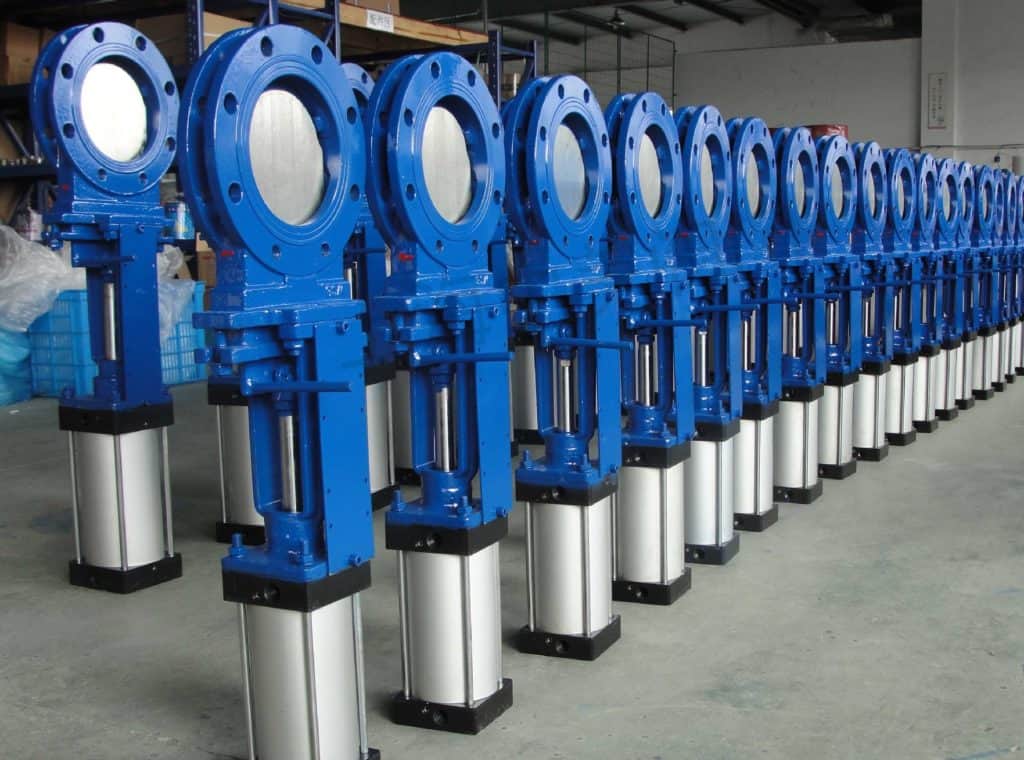
What is the difference between knife gate valves and gate valves?
In this article, you can read about the difference between knife gate valves and gate valves. Both the wedge-type gate valves and the knife gate valves are primarily designed for on-off services where the valve is completely opened or completely closed. It is not recommended to use either of these to regulate flow because when fluid pushes against a partially closed gate, vibration occurs, and cavitation will eventually damage the seat and the body. Also, both valve types are designed to open and close slowly to reduce the risk of water hammer.
Both types can be used in applications involving:
- Slurries
- Heavy oils
- Non-flammable viscous fluids
- Wastewater
- Clean water
The difference between knife gate valves and gate valves and What makes them similar?
Gate and knife gate valves are primarily for on/off service. Using these types of valves to regulate flow is not recommended because when fluid pushes against a partially closed gate vibration occurs, eventually wearing and eroding the seat and disk. For that reason, these types of valves should be either completely opened or completely closed.
These valves are also designed to open and close slowly to protect from the effects of water hammer.
The difference between knife gate valves and gate valves
One of the differences between the gate and the knife gate valves is that the knife gate valve often has a sharpened disc to better cut through slurry/viscous media. Also, the knife gate valve has a short face-to-face length compared to a gate valve, which is dimensionally wider. As a consequence, a knife gate valve is lightweight compared to a gate valve. These are the main differences and probably two of the biggest advantages of the knife gate valve.
Knife gate valves are typically found in wastewater treatment plants, chemical plants, mining, and cement plants as well as in many other industrial applications while gate valves are typically found in drinking water mains, distribution networks, and drinking water pump stations.
The differences between them are vast. First off, yes, the knife gate valve DOES have a sharpened disk (thank you very much). This is meant to sever any stringent solids that may keep the valve from closing and causing it to leak. But there’s more that makes their designs quite different.
The biggest difference between these two types of valves
That gate valves are built to ANSI standards while knife gate valves adhere to TAPPI standards. Therefore, dimensionally the gate valve is wider, flanged, and ANSI pressure-rated. It also has API leak tightness standards that must be met. They’re bi-directional, and commonly used in steam applications as well as fluid applications. The gate valve is only available with metal seats.
Another significant difference between an ANSI gate valve and a knife gate valve is in the packing gland area. A gate valve will have a v-ring packing set that seals the shaft attached to the gate, while a knife gate valve has a packing gland that seals around the gate.
A knife gate has a very thin profile compared to its bulkier counterpart. It’s also uni-directional (though bi-directional is an option on some), and comes in either a wafer or lugged body, with no flanges. The seats on the knife gate valve come in everything from metal to resilient types.
Two of the knife gate’s biggest advantages knife are weight and expense. A 16” knife gate valve will typically weigh less than 300# while an ANSI gate valve will be in excess of 1200#. The cost of the valve is similar to the weight difference as well.
A knife gate valve was initially designed for the pulp and paper industry. When stringy pulp impinges between the wedge and the sand seat to prevent flow shut-off, a knife valve is used to deal with it. It features a sharp edge to cut through the pulp and seal to deal with viscous fluids with a similar impingement risk.
This valve type is typically employed in heavy oil, wastewater, paper and pulp, and sludge and slurry industries. These devices are generally specified in larger sizes to handle viscous flows in several demanding applications.
Primary Advantages of Using a Knife Valve:
- It is easy to actuate and light and is available in several affordable options.
- It is best for applications with viscous fluids as its blades can easily cut through thick liquids.
- Despite these advantages, a knife valve may sometimes cause significant inconvenience to the users.
Some Disadvantages of Using a Knife Valve:
- It is widely known for its low-pressure limitations.
- It is a less desirable shut-off valve for applications requiring cleanliness and optimal hygiene conditions.
- The function of a knife valve diminishes when used in dry bulk applications. Its blade fits into an elastomer seal after it cuts through the media. Over time, the seal becomes abraded and may influence the sealing performance, leading to downtime, decreased production and negatively impacting revenue streams.


























